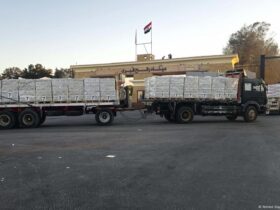Ecosystems are warning that the mainland South East Asia faces an emerging ecological disaster until immediate steps are taken to address the rare-earth mining boom in the war-torn Myanmar.
According to a London-based watchdog, Global Witness, Myanmar has become the world’s largest source of heavy rare-earth elements. Thesis minerals are essential for the manufacture of high -tech products such as wind turbines, electric vehicles and medical devices.
Most of the thesis mines are located in the Shaan State, where civil war has increased since the 2021 military coup.
Earlier this year, Thailand’s Pollution Control Department found a Mekong tributary flowing from Myanmar to Thailand to about four times higher arsenic than the Health Organization (WHO) in some parts of the Coke River. Other toxic metals were therefore found at dangerous levels.
Coke passes through the Chiang Rai province in northern Thailand before merging with Mekong, where arsenic concentrations allegedly beat.
Mekong is the longest river in South East Asia, providing a lifeline for millions of people. Experts fears that contamination may leak into irrigation systems that feed the fields of the area and the vast parts of the drinking water supply. Who is it InformedProlonged contact for arsenic and other metals can cause cancer, neurological disorders and organ failure.
“Now what we see is just the beginning,” Pianporn Dates, International River’s campaign director, a conservation NGO, told DW.
“If left uncontrolled, the situation may deteriorate rapidly – upstream of potential hundreds of irregular mines, heavy contaminations through the mekong and its tributaries, and eventually reaches as the sea from water acidification,” he said.
Limited option
Following the petitions of local communities in June, Thai officials built underwater sediment or mini-dams on the coke to trap the toxic deposits before reaching the villages.
Environmental groups say that the search infrastructure will take years to complete, while the crisis is already coming out.
Bangkok has some options. This problem is largely read within the boundaries of Myanmar, especially in the state of Shan, where new mines are located in the area controlled by the United WA State Army (UWSA), a powerful China -backed militia that oversees two semi -autonomous enclaves.
Reuters have reported that UWSA provides armed security for Chinese-managed mining works there. Neither the military ruler of Myanmar nor the international organizations have meaningful control over the region.
Currently, it is unknown whether pollution is concentrated in North Thailand or whether it has already backed in Mecong, which is affecting the Downstream nations.
It is “extremely likely” that toxic metal and chemicals are already detected in Cambodia, where 60% of the country’s protein intake from the Mecong River told DW, the director of the Junglee, Bryan Ailler, Stimson Center Asia Program, told DW.
In recent weeks, Civil Society groups have called for strong action in the 1990s from the Mekong River Commission (MRC) established by Cambodia, Laos, Thailand and Vietnam, which is in the 1990s to manage shared waterways.
“MRC must install monitoring stations for immediate heavy metals and ensure that there is timely access to accurate and transparent information across the basin,” Pianporn urged.
But MRC has so far reduced the danger. In July, it reported arsenic level above the security boundaries on four of the five samples in Thailand and Laos, yet the situation was only eliminated as “minor serious transboundary environmental issues”.
Many analysts agree that the final responsibility is with Beijing, which controls about 60% of global rare earth production and about 90% of refinement.
China, the world’s largest user in the world of rare earth minerals, underlines several forms of rare-earth mining at home in the 2010s because it worries about environmental damage.
However, thesis environmental safety measures established many Chinese companies to move south and establish their operations on the border in Kachin and Shaan states of Myanmar.
In 2018, the Myanmar -led government had banned exports and ordered Chinese miners to reduce operations, but since 2021, a withdrawal has continued to be extracted amidst a civic struggle.
Beijing has “demanded effective export of rare earth mineral extraction to other countries. And now the practice has spread to the next door in the ETNIC autonomous region of Myanmar, where it is booming over irregular fashion,” Eyler said.
Can the situation be worse?
Beijing should suggest that all rare earth imports come only from mines that comply with its laws and environmental standards, Pianporn told DW.
Shehe said, “If China is a leader on ‘ecological civilization’, it should work in a accountable and transparent manner.”
However, China’s reaction to Beijing Wood against its selfishness, because the global race thesis for the rare Earth is a conflict for the control of significant materials.
The way it goes against the way of conducting foreign policy in an region like Southeast Asia, the lecturer, assistant professor MLA MLA Atmacharch said in the South East Asian study at the Thomasit University.
In bilateral behavior, China always emphasizes the principles of state sovereignty, in which Beijing emphasizes that it does not interfere with the affairs of any other country, including its environmental law.
For example, Beijing may say that it has no effect on rare-earth mining in Myanmar because the monitoring of environmental damage comes within the sovereign of Myanmar, nor China needs “to consider the problem for other downstream states,” Prikelark told DW.
The rush of rare-earth is not limited to Myanmar. Laos has been identified at least 15 mines with tributaries of Mekong. Cambodia currently has a lack of active large -scale rare earth mines, but investigation continues.
Environmentalists are afraid of a regional chain response of pollution on Mekong.
Eler of the Stimson Center told DW, “The situation likes that it becomes better before it becomes.”
He said, “It is possible that the population of the entry river is contaminated, and the flooding, which is an agricultural production area for the world, is unusable for a long time,” he said.
For now, Mekong is still seen as one of the world’s great clean rivers. But experts fear that reputation may soon be lost.
Edited by: Keith Walker






Leave a Reply